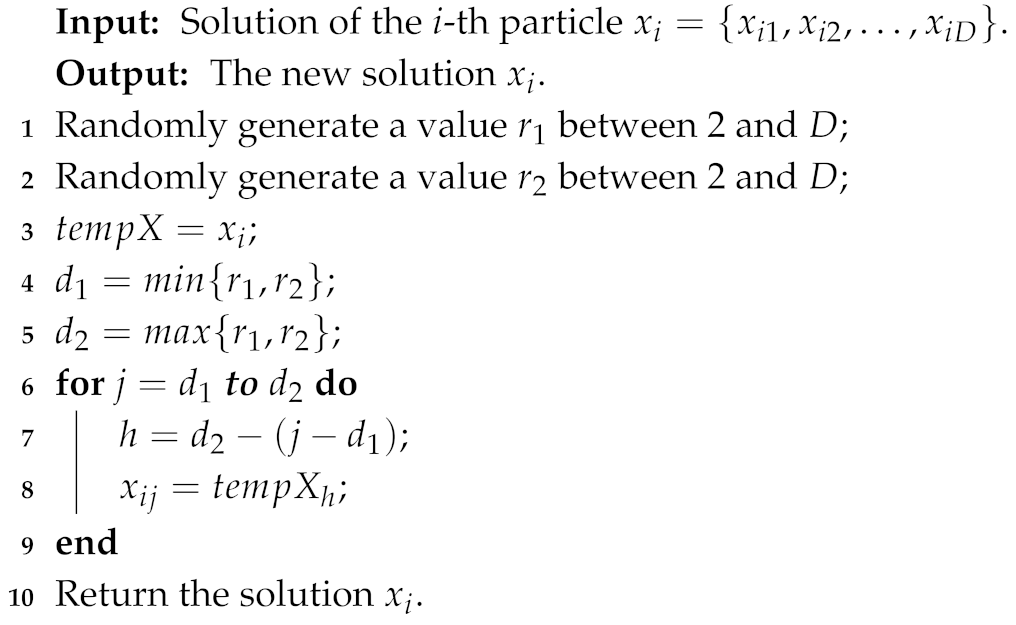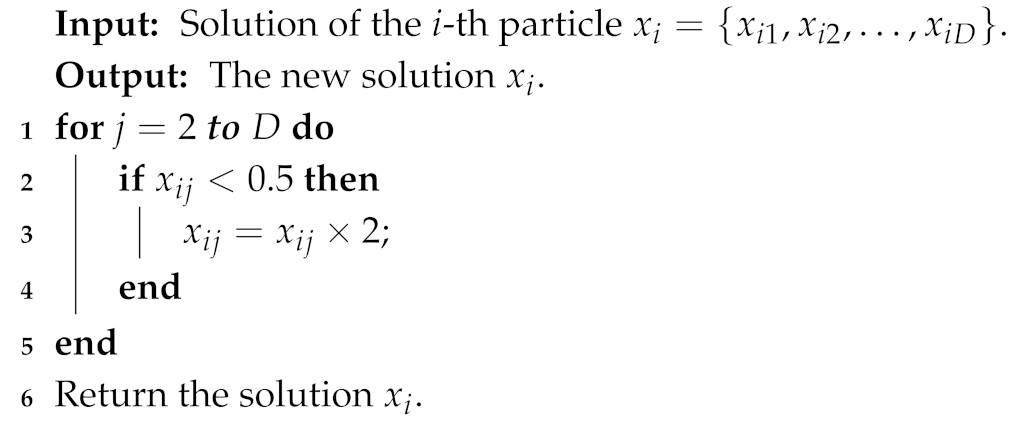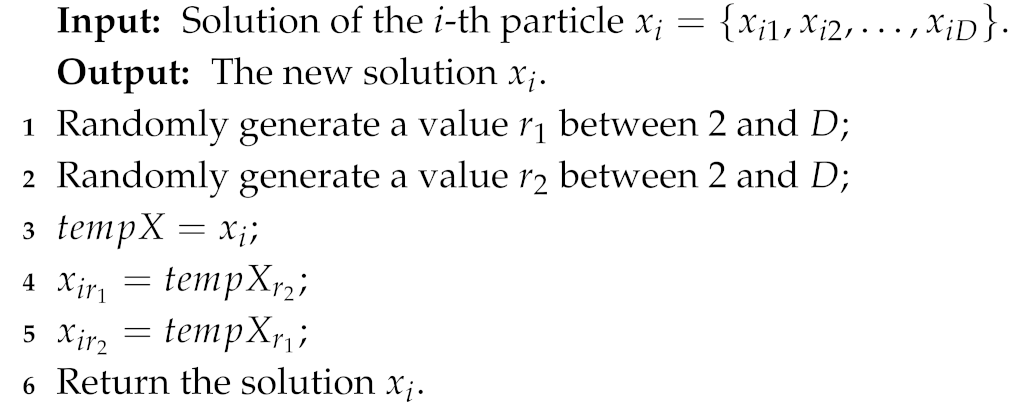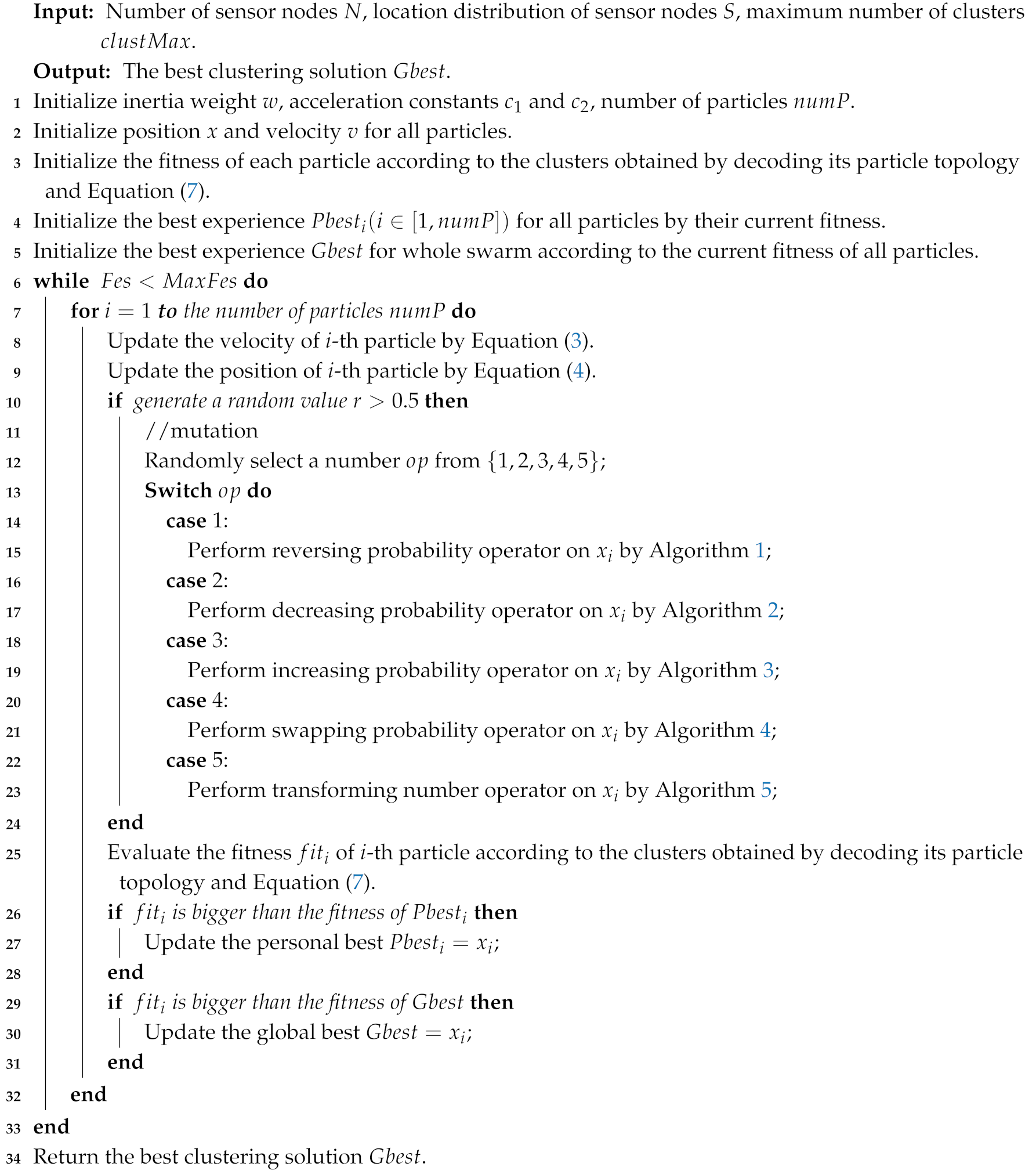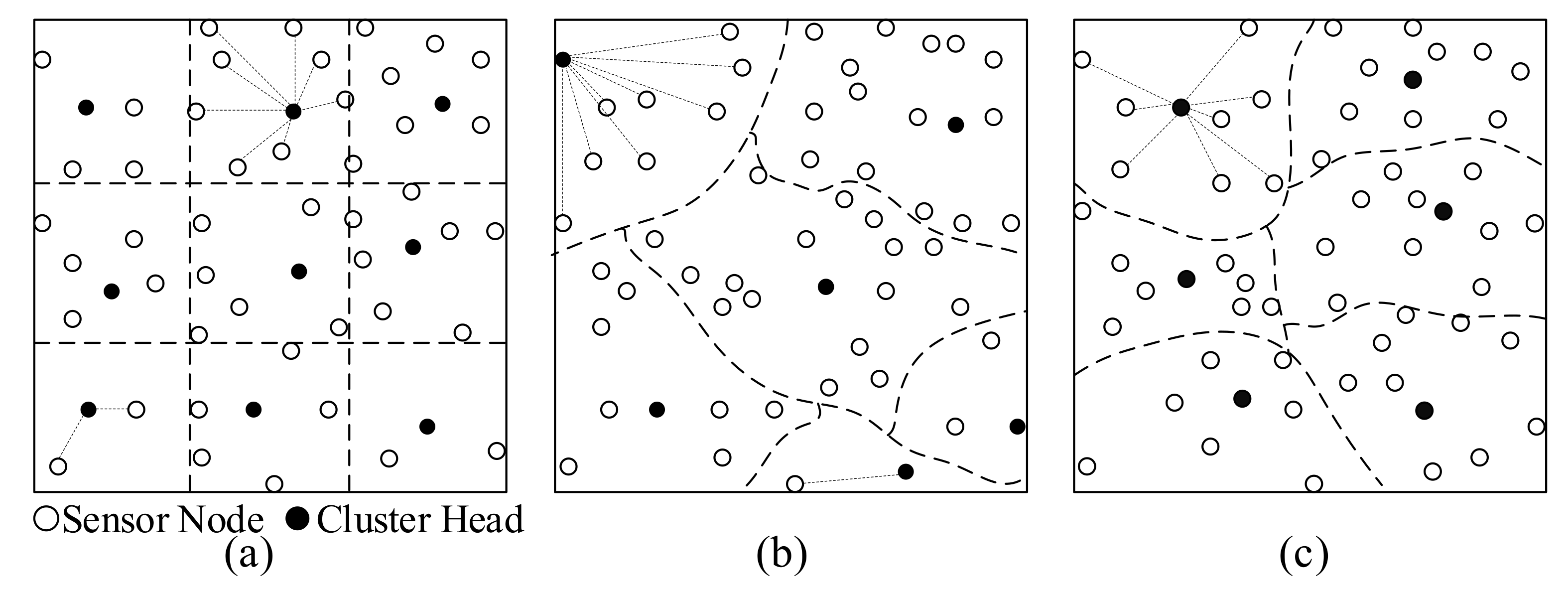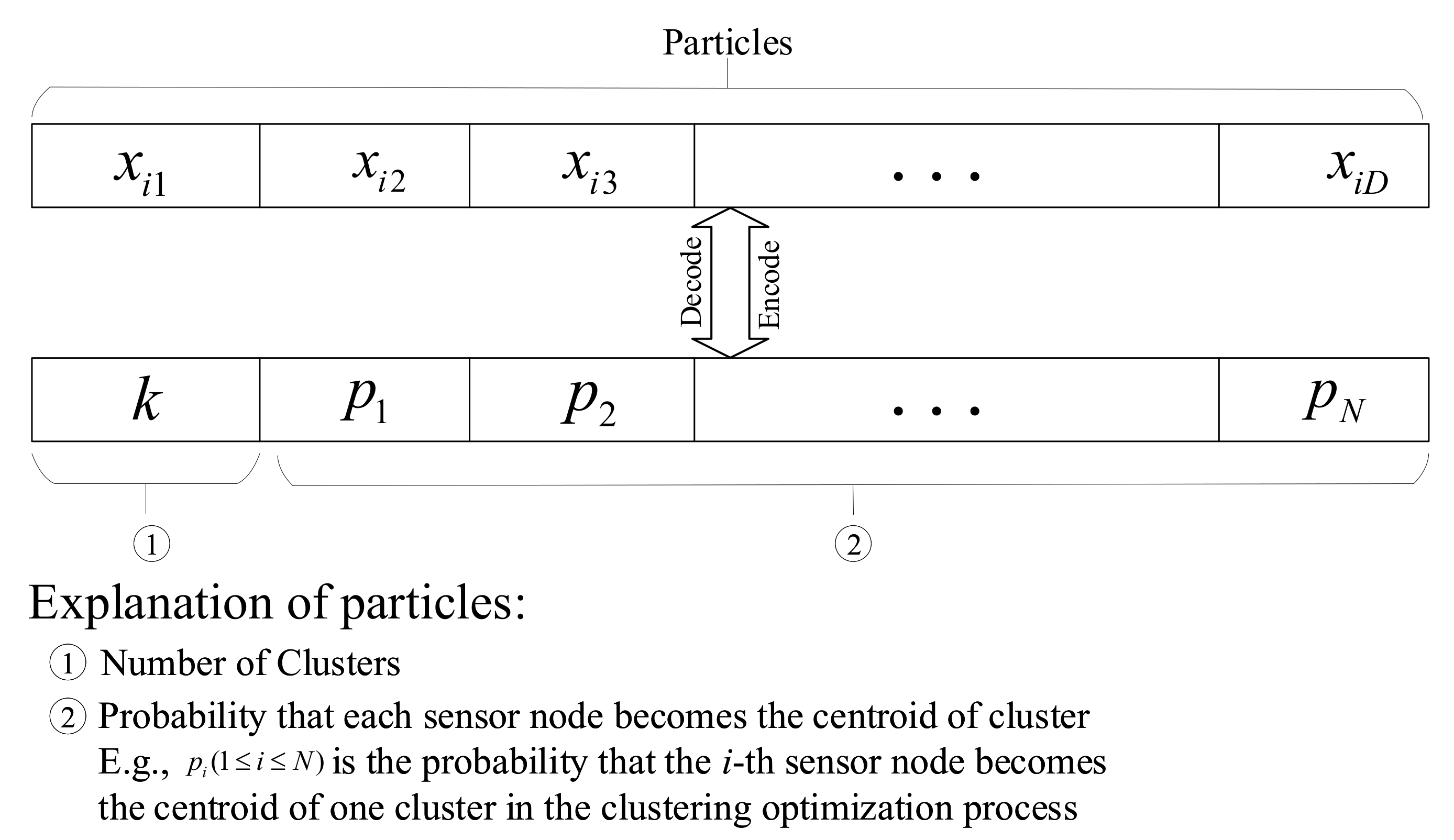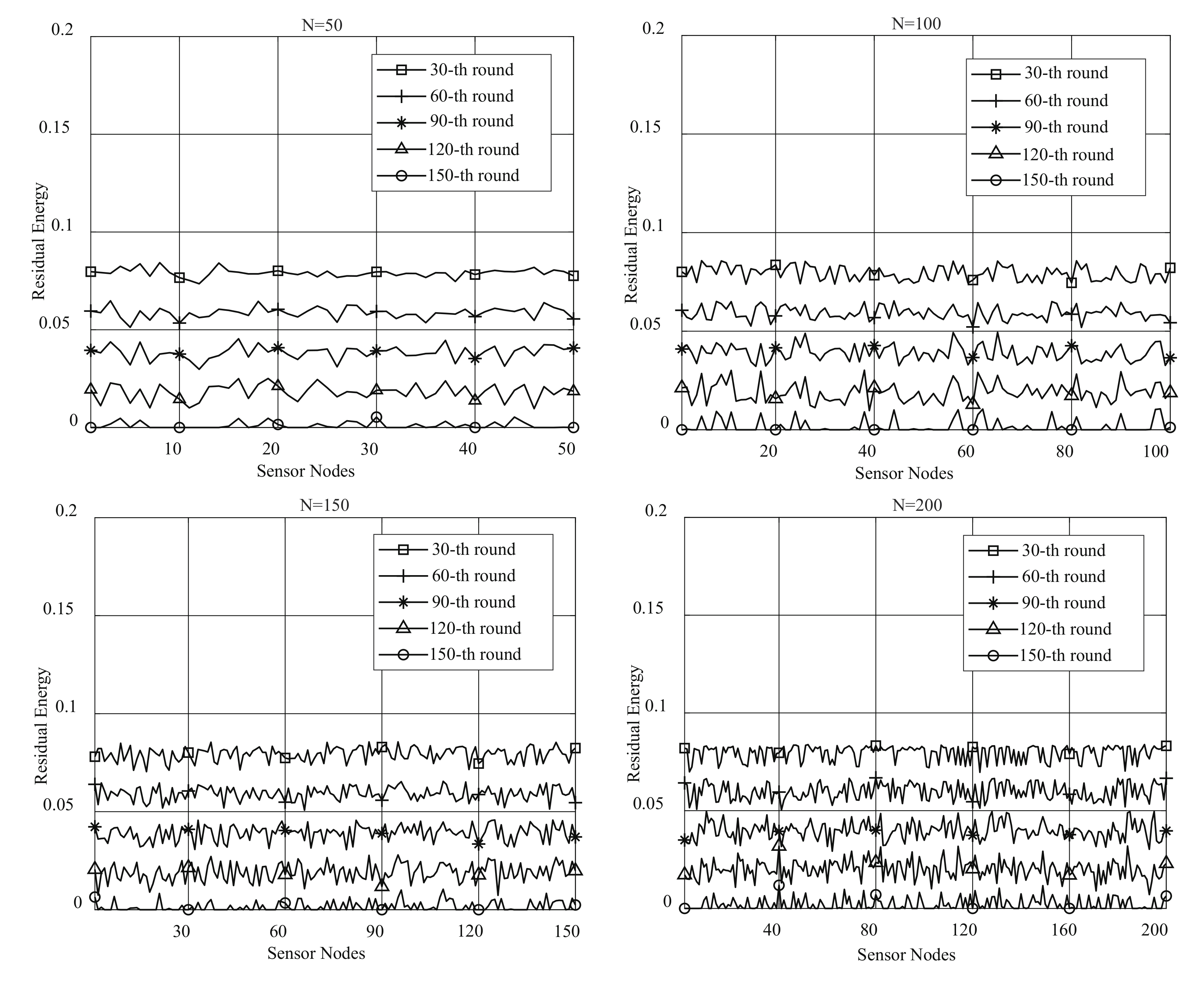This section presents several simulations performed using MATALAB to evaluate the effectiveness and performance of the proposed EBCRP method. The effectiveness of EBCRP is first validated in terms of the clustering performance and balanced energy consumption of sensor nodes. Further, simulations are also performed to compare EBCRP with some existing methods, namely, LEACH [
9], SEP [
29], and IICMH [
37] in terms of the network lifetime and balancing the energy consumption. For the simulations, the sensing region is set to 100 m × 100 m; the number of sensor nodes
N is varied from 50 to 200. Some parameters of the WSN system are listed in
Table 1.
5.1. The Effectiveness of EBCRP
In EBCRP, an adaptive sensor node clustering scheme based on PSO is proposed to determine the number of clusters and group sensor nodes into clusters evenly. Additionally, five mutation operators are specially proposed to improve the performance of PSO in optimizing sensor node clustering. This subsection examines the effectiveness of the proposed EBCRP method.
The effectiveness of PSO and five mutation operators in EBCRP are verified. PSO with five mutation operators (PSO-FMO) and without five mutation operators (SPSO) are compared. The same parameters are used for both PSO-FMO and SPSO. The population size is set to 50. Acceleration constants
and
are set to 1.5 and 2.0, respectively. The number of fitness evaluations (FEs) is set to 10,000.
Figure 5 shows the sensor node clustering results based on SPSO and PSO-FMO for different numbers of sensor nodes (50, 100, 150 and 200).
It can be noticed from the figure that while both PSO-FMO and SPSO group the sensor nodes scattered into clusters in the sensing region R. However, the allocation of cluster centroids by SPSO is not reasonable. For example, the clusters highlighted by circles have extremely asymmetrical centroids, which results in an increased distance between sensor nodes and their centroids and thus a deceased fitness . Furthermore, the result of SPSO also shows the imbalance of the number of sensor nodes between clusters, which is shown in the clusters highlighted by square. These results indicate the weak performance of SPSO, the method that does not use the five mutation operators in optimizing sensor node clustering. In contrast, PSO-FMO achieves more reasonable cluster centroids and a better balance of the number of sensor nodes between clusters. This is because the use of five mutation operators increases the search diversity, thus improving the probability of finding a better sensor node clustering solution. Therefore, the use of PSO-FMO justifies the good performance of EBCRP in optimizing sensor node clustering.
Figure 6 illustrates the mean convergence curves of SPSO and PSO-FMO in optimizing sensor nodes clustering.
To reduce the statistical error, both methods are run 30 times under the same conditions. It can be noticed from the figure that PSO-FMO achieves a higher average fitness for different numbers of sensor nodes compared to SPSO. SPSO converges quickly and falls into a local optima. In contrast, PSO-FMO continuously searches the best solution and avoids falling into local optima. This is because the five mutation operators continuously provide the diversity of particles for the entire swarm, which helps particles find a better solution. Hence, the mean convergence curves also verify the effectiveness of PSO-FMO in EBCRP.
To verify the effectiveness of PSO-FMO in balancing the number of sensor nodes between clusters,
Table 2 also gives the comparison of balance index of the number of sensor nodes between clusters. It can be noticed from the table that PSO-FMO achieves a better balance for different numbers of sensor nodes, which also indicates the effectiveness of PSO-FMO in EBCRP.
To verify the effectiveness of EBCRP method in balancing the energy consumption of sensor nodes, the residual energy of sensor nodes during the network lifetime is analyzed.
Figure 7 shows the residual energy of each sensor node in different rounds for different numbers of sensor nodes (50, 100, 150 and 200).
While the residual energies of sensor nodes fluctuate up and down, it still demonstrates balance within a small energy range. In sensor node clusters, some sensor nodes are dynamically selected as CHs, while others are selected as cluster members. The rates of energy consumption of CHs and cluster members are different. Therefore, there are some sensor nodes with a higher energy consumption. Furthermore, all sensor nodes cannot consume energy completely synchronously. Small range fluctuations of the residual energy of sensor nodes prove the effectiveness of EBCRP in balancing the energy consumption of sensor nodes.
5.2. Comparison of EBCRP with Other Methods
To validate the performance of the proposed EBCRP method, it was compared to other methods, namely, LEACH [
9], SEP [
29], and IICMH [
37]. The LEACH protocol selects some sensor nodes as CHs according to a random probability of each node. Other sensor nodes were assigned to corresponding CHs based on the received signal strength. SEP is similar to LEACH, except that a certain proportion of sensor nodes in SEP are equipped with more energy, and CHs are selected based on the residual energy of each sensor node. IICMH adopts iterative self-organizing data analysis techniques algorithm to select clustering centers; then, CHs are selected based on the distance between sensor nodes and the clustering centers. When the residual energy of CHs is lower than a set threshold, CHs are reselected based on the residual energy of sensor nodes.
To fully compare the performance of each method, simulations were performed for four different numbers of sensor nodes: 50, 100, 150 and 200. For LEACH and SEP, 5% of sensor nodes were selected as CHs. For the IICMH and EBCRP methods, 5% of sensor nodes are set as the expected number of clusters and a maximum number of clusters, respectively.
Figure 8 shows the number of dead sensor nodes for the different methods in different rounds.
The first row displays the number of dead sensor nodes from 0 to 300 rounds, while the second row shows the round corresponding to the first dead sensor node for each method. It can be noticed from the figure that the number of dead sensor nodes in LEACH and SEP increases slowly. It is obvious that some sensor nodes consume energy too fast, while others consume energy slowly due to the unbalanced energy consumption of sensor nodes in LEACH and SEP. In contrast, IICMH considers the balance of the number of sensor nodes between clusters when clustering sensor nodes, which helps balance the energy consumption of sensor nodes. Therefore, there is a period of a sharp increase in the number of dead sensor nodes. Nevertheless, IICMH still does not deal with the energy balance of sensor nodes well as some sensor nodes ran out of energy prematurely. EBCRP only shows a period of a sharp rise in the number of dead sensor nodes, whereas there is no problem of sensor nodes consuming energy prematurely. This is because EBCRP balances the energy consumption of sensor nodes well by balancing the number of sensor nodes between clusters and employing the rotation CH selection scheme based on the highest residual energy. It can be noticed that the first dead sensor node appears in a later round for EBCRP compared to the other methods, which also indicates that the energy balance of sensor nodes in EBCRP is better. Overall, EBCRP presents a good performance in balancing the energy consumption of sensor nodes.
To further verify the balance of energy consumption between sensor nodes in EBCRP, the energy consumption balance index (ECBI) is calculated based on the fairness index as shown in Equation (
9).
where
is the energy consumption of the
i-th sensor node.
Figure 9 compares the curve of ECBI of different methods during rounds.
In addition,
Table 3 also quantitatively compares the ECBI between the proposed EBCRP method and other methods in 30-th, 60-th, 90-th, 120-th, and 150-th rounds under the different number of sensor nodes (50, 100, 150 and 200), in which the best EBCI value is bolded for each round.
From
Figure 9 and
Table 3, it can be observed that the ECBI of all the methods increases gradually with the increase of rounds from 1 to 150 for all the case with different numbers of sensor nodes. This is because more and more sensor nodes consume a lot or even all energy with the increase of rounds, which will raise the ECBI. Also, the proposed EBCRP method and these comparison methods dynamically select CH for each cluster, which can balance the energy consumption between sensor nodes. However, the ECBI of the proposed EBCRP method is significantly higher than that of the other methods in different rounds. This is because LEACH and SEP randomly select some sensor nodes as CHs, and then other sensor nodes are assigned to their respective nearest CHs, which ignores the balance of the number of sensor nodes between clusters and increases the imbalance of energy consumption between sensor nodes. In contrast, during sensor node clustering, IICMH and the proposed EBCRP take into account the balance of the number of sensor nodes between clusters, thereby helping to balance the energy consumption of sensor nodes. Nevertheless, in the IICMH method, the CH of each cluster is reselected after the energy of the previous CH is lower than a threshold. This makes the energy of sensor nodes selected as CHs for the first time consume more energy. On the contrary, the used rotation CH selection based on the highest residual energy in the proposed EBCRP method can effectively balance the energy consumption between sensor nodes. So the ECBI of IICMH is lower than that of the proposed EBCRP method. The significantly higher ECBI of the proposed EBCRP than other methods prove the effectiveness of EBCRP in balancing the energy consumption between sensor nodes. Furthermore, EBCRP shows a high ECBI in different rounds, whereas the other methods show significantly smaller ECBI in the early rounds than in the later rounds. This also proves the advantages of EBCRP over other methods. Therefore, the proposed EBCRP performs well in balancing the energy consumption of sensor nodes. However, the proposed EBCRP method dynamically selects CH for each cluster in each round, which reduces the stability of the network system.
The network lifetime of EBCRP is also compared with other methods.
Figure 10 illustrates the network lifetime of different methods for different numbers of sensor nodes.
EBCRP achieves the longest lifetime compared to LEACH, SEP, and IICMH. There are two main factors that prolong the network lifetime of EBCRP. First, EBCRP employs an adaptive sensor node clustering scheme to determine the number of clusters and group sensor nodes into clusters evenly. This helps to balance the energy consumption between clusters. Second, EBCRP adopts a rotation CH selection scheme based on the highest residual energy to dynamically select CHs for each cluster. This approach can balance the energy consumption of sensor nodes within each cluster. Balancing the energy consumption between clusters and within clusters in EBCRP prevents some sensor nodes from consuming energy prematurely, thereby prolonging the lifetime of the WSN. However, LEACH and SEP randomly select some sensor nodes as CHs, while other sensor nodes are assigned to their respective nearest CHs, which cannot balance the number of sensor nodes between clusters and energy consumption of sensor nodes. At the same time, a certain proportion of sensor nodes in SEP are equipped with more energy, and CHs selection in SEP takes into account the residual energy of sensor nodes. Thus, the network lifetime of SEP is higher than that of LEACH, but it is still lower than the proposed EBCRP method. Although the IICMH also considers the balance of the number of sensor nodes between clusters, the CH of each cluster is reselected after the energy of the previous CH is lower than a threshold. This makes the energy of sensor nodes selected as CHs for the first time to quickly depleted. In addition, sensor nodes close to the sink in each cluster are preferentially selected as CHs in IICMH, which increases the energy consumption of some sensor nodes (i.e., cluster members far away from their CHs) when they send data to their CHs. Thus, the network lifetime of IICMH is lower compared to the other methods. Overall, the proposed EBCRP method performs better in prolonging the network lifetime by performing balanced clustering and employing the rotation CH selection scheme based on the highest residual energy.
